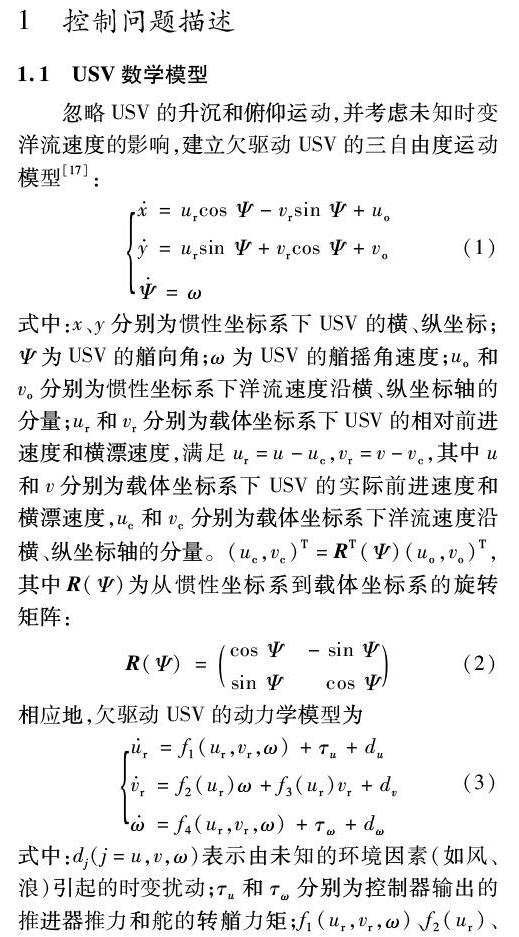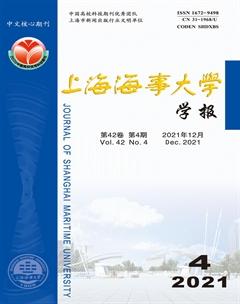基于改进自适应积分视线制导方法的欠驱动无人水面艇路径跟踪控制
白一鸣 刘磊 韩新洁

摘要:为提高无人水面艇(unmanned surface vehicle, USV)对复杂海况的适应性,针对欠驱动USV的路径跟踪控制问题,设计基于改进的自适应积分视线(improved adaptive integral line-of-sight, IAILOS)制导方法和径向基神经网络(radial basis function neural network, RBFNN)的积分滑模路径跟踪控制器。在IAILOS制导方法中,引入降阶的扩张状态观测器估计未知时变洋流速度,从而使得该制导方法不仅可以估计时变漂角,而且可以补偿未知时变洋流的扰动。利用RBFNN的无限逼近特性来估计USV动力学模型中的不确定项和未知的外部环境干扰。通過稳定性分析和仿真对比实验,验证了本文所设计的控制器的准确性和鲁棒性。
关键词: 无人水面艇(USV); 路径跟踪控制; 改进的自适应积分视线(IAILOS)制导方法; 径向基神经网络(RBFNN); 滑模控制
中图分类号: U664.82 文献标志码: A
Abstract: To improve the adaptability of unmanned surface vehicles (USVs) to complex sea conditions, aiming at the path following control of underactuated USVs, an integral sliding-mode path following controller is designed based on the improved adaptive integral line-of-sight (IAILOS) guidance law and the radial basis neural network (RBFNN). The reduced-order extended state observer is introduced to estimate the unknown time-varying ocean current velocity in the IAILOS guidance law, so that the guidance law can not only estimate the time-varying drift angle, but also compensate the disturbances of unknown time-varying ocean currents. The infinite approximation property of RBFNN is used to estimate the uncertain terms in the USV dynamic model and the unknown external environment disturbances. The accuracy and robustness of the controller are verified through the stability analysis and simulation comparison experiments.
Key words: unmanned surface vehicle (USV); path following control; improved adaptive integral line-of-sight (IAILOS) guidance law; radial basis function neural network (RBFNN); sliding-mode control
0 引 言
无人水面艇(unmanned surface vehicle, USV)的路径跟踪控制目标是控制USV跟踪几何平面内的一条理想的参数化路径,并且没有时间限制[1]。针对USV的路径跟踪控制问题,国内外学者提出的主要控制方法有:比例积分微分(proportional-integral-derivative, PID)控制、反馈线性化、反步法、预测控制、滑模控制等[2-4]。在USV的控制系统中,通过将控制算法与制导方法相结合,可以大大提高USV操纵的安全性[1]。视线(line-of-sight, LOS)制导方法由于具有简单高效、易于实现等优点,被广泛应用到USV的路径跟踪控制器设计中。
LOS制导方法通过模仿熟练的操舵人员的操纵行为,利用超前视距跟踪理想路径上的前方一点,以实现路径跟踪的目的[5]。文献[6-7]提出比例LOS制导方法,并且证明了该制导方法的一致半全局指数稳定性。然而,USV由于体积小,在实际的航行过程中极易受到外界环境的干扰,进而产生漂移,因此比例LOS制导方法具有一定的局限性。漂移产生的角度(即漂角), 可以通过传感器进行测量,但是当传感器存在噪声时,难以测得精确的漂角。针对未知漂角的问题,文献[8]通过引入积分方法来消除环境干扰所导致的漂移,文献[9-11]通过设计基于预估器的LOS制导方法估计常值漂角,文献[12-13]则通过在LOS制导方法中引入有限时间观测器来估计时变漂角。然而,文献[8-13]均假设环境干扰为USV动力学层面的干扰力或力矩,未考虑洋流在运动学层面上对USV位置和速度的影响。为此,文献[14]设计了干扰观测器来估计和补偿未知洋流速度,文献[15]通过自适应的方式抵消洋流的影响,但这两篇文献均假设USV的漂角已知。综上所述,基于LOS制导方法的路径跟踪策略需要解决3个方面的问题:一是未知的时变漂角;二是未知的时变洋流速度;三是未知的干扰力和力矩。
针对漂角和洋流速度均未知的情况下USV的路径跟踪问题,本文首先借鉴文献[16]对未知漂角的自适应律,改进文献[15]提出的LOS制导方法,并且引入降阶扩张状态观测器(extended state observer, ESO)来估计未知的时变洋流速度,从而提出一种改进的自适应积分视线(improved adaptive integral line-of-sight, IAILOS)制导方法。IAILOS制导方法不仅能通过积分项来估计时变漂角,而且能精确地估计时变洋流速度,从而抵消未知时变洋流在运动学层面对USV的影响。相较于文献[5]和文献[16]提出的自适应律,降阶ESO对未知时变洋流速度的估计更加精确。然后,应用滑模控制理论设计速度和姿态控制器,并且引入径向基神经网络(radial basis function neural network, RBFNN)算法,利用其良好的逼近特性来估计未知的干扰力和力矩以及USV动力学模型中的不确定项。最后,通过稳定性证明和仿真对比实验验证该控制算法的可靠性和鲁棒性。
1 控制問题描述
1.1 USV数学模型
由于本文考虑了无旋且时变洋流速度在运动学层面对USV路径跟踪的影响,所以洋流速度的估计结果对该LOS制导方法的有效性也是至关重要的。由图6可知,降阶ESO可以准确地估计时变洋流速度,这也证明本文通过降阶ESO对AILOS的改进是有效的。图7、8、9分别展示了USV的相对前进速度、艏向角、艏摇角速度的跟踪曲线,图中的urd、Ψd和ωd分别表示其理想值。从图中可以看出,实际值可以在合理的时间内跟踪上理想值,这充分证明了本文所设计的积分滑模控制器是有效的。由于外部环境的干扰不仅会在运动学层面使USV产生漂移作用,还会在动力学模型中产生未知的干扰力和力矩,而且USV的模型参数也很难确定,所以本文将未知时变干扰和模型不确定项合并成一项(fu,fω),通过引入RBFNN对其进行估计。图10展示了fu、fω及其估计值f ^u、f ^ω的曲线,结果显示RBFNN可以有效地逼近模型中的不确定项和外部环境干扰,从而证明RBFNN的引入提高了该控制器的鲁棒性。
由图11可知,控制器输出的推力和转艏力矩最终的稳定范围也符合实际情况。综上所述,本文提出的基于IAILOS制导方法和RBFNN的积分滑模控制器是有效的。
6 结 论
本文针对复杂海洋环境下欠驱动水面无人艇(USV)的路径跟踪问题,设计了基于改进自适应积分视线(IAILOS)制导方法的积分滑模路径跟踪控制器。该视线(LOS)制导方法引入了文献[16]的漂角自适应律和降阶扩张状态观测器,对文献[16]提出的制导方法进行了改进,不仅能够估计未知时变洋流速度而且消除了时变漂角所产生的影响。此外,在控制器设计部分,引入了径向基神经网络,利用其逼近特性对模型不确定项和未知环境干扰进行估计,并与积分滑模控制算法相结合,设计了路径跟踪控制律。通过稳定性分析,证明路径跟踪误差是最终一致有界的,验证了该算法的理论可行性。最后的仿真对比实验也证明了本文所提出的控制方法的准确性和鲁棒性。
参考文献:
[1] 刘陆. 欠驱动无人船的路径跟踪与协同控制[D]. 大连: 大连海事大学, 2018.
[2] ASHRAFIUON H, MUSKE K R, MCNINCH L C. Review of nonlinear tracking and setpoint control approaches for autonomous underactuated marine vehicles[C]//Proceedings of the 2010 American Control Conference. IEEE, 2010: 5203-5211. DOI: 10.1109/ACC.2010.5530450.
[3] LIU Zhixiang, ZHANG Youmin, YU Xiang, et al. Unmanned surface vehicles: an overview of developments and challenges[J]. Annual Reviews in Control, 2016, 41: 71-93. DOI: 10.1016/j.arcontrol.2016.04.018.
[4] 廖煜雷, 张铭钧, 董早鹏, 等. 无人艇运动控制方法的回顾与展望[J]. 中国造船, 2014, 55(4): 206-216. DOI: 10.3969/j.issn.1000-4882.2014.04.025.
[5] NIE Jun, LIN Xiaogong. Improved adaptive integral line-of-sight guidance law and adaptive fuzzy path following control for underactuated MSV[J]. ISA Transactions, 2019, 94: 151-163. DOI: 10.1016/j.isatra.2019.04.010.
[6] FOSSEN T I, BREIVIK M, SKJETNE R. Line-of-sight path following of underactuated marine craft[J]. IFAC Proceedings Volumes, 2003, 36(21): 211-216. DOI: 10.1016/S1474-6670(17)37809-6.
[7] FOSSEN T I, PETTERSEN K Y. On uniform semiglobal exponential stability (USGES) of proportional line-of-sight guidance laws[J]. Automatica, 2014, 50(11): 2912-2917. DOI: 10.1016/j.automatica.2014.10.018.
[8] BORHAUG E, PAVLOV A, PETTERSEN K Y. Integral LOS control for path following of underactuated marine surface vessels in the presence of constant ocean currents[C]//2008 47th IEEE Conference on Decision and Control. IEEE, 2008: 4984-4991. DOI: 10.1109/CDC.2008.4739352.
[9] YU Yalei, GUO Chen, YU Haomiao. Finite-time PLOS-based integral sliding-mode adaptive neural path following for unmanned surface vessels with unknown dynamics and disturbances[J]. IEEE Transactions on Automation Science and Engineering, 2019, 16(4): 1500-1511. DOI: 10.1109/TASE.2019.2925657.
[10] YU Yalei, GUO Chen, YU Haomiao. Finite-time predictor line-of-sight-based adaptive neural network path following for unmanned surface vessels with unknown dynamics and input saturation[J]. International Journal of Advanced Robotic Systems, 2018, 15(6): 1-14. DOI: 10.1177/1729881418814699.
[11] LIU Lu, WANG Dan, PENG Zhouhua, et al. Predictor-based LOS guidance law for path following of underactuated marine surface vehicles with sideslip compensation[J]. Ocean Engineering, 2016, 124: 340-348. DOI: 10.1016/j.oceaneng.2016.07.057.
[12] WANG Ning, SUN Zhuo, YIN Jianchuan, et al. Finite-time observer based guidance and control of underactuated surface vehicles with unknown sideslip angles and disturbances[J]. IEEE Access, 2018, 99: 1. DOI: 10.1109/ACCESS.2018.2797084.
[13] WANG Ning, SUN Zhuo, ZHENG Zhongjiu, et al. Finite-time sideslip observer-based adaptive fuzzy path-following control of underactuated marine vehicles with time-varying large sideslip[J]. International Journal of Fuzzy Systems, 2017, 20: 1767-1778. DOI: 10.1007/s40815-017-0392-0.
[14] FOSSEN T I, LEKKAS A M. Direct and indirect adaptive integral line-of-sight path-following controllers for marine craft exposed to ocean currents[J]. International Journal of Adaptive Control and Signal Processing, 2017, 31(4): 445-463. DOI: 10.1002/acs.2550.
[15] ZHENG Zewei, SUN Liang. Path following control for marine surface vessel with uncertainties and input saturation[J]. Neurocomputing, 2016, 177: 158-167. DOI: 10.1016/j.neucom.2015.11.017.
[16] FOSSEN T I, PETTERSEN K Y, GALEAZZI R. Line-of-sight path following for Dubins paths with adaptive sideslip compensation of drift forces[J]. IEEE Transactions on Control Systems Technology, 2015, 23(2): 820-827. DOI: 10.1109/TCST.2014.2338354.
[17] CAHARIJA W, CANDELORO M, PETTERSEN K Y, et al. Relative velocity control and integral LOS for path following of underactuated surface vessels[J]. IFAC Proceedings Volumes, 2012, 45(27): 380-385. DOI: 10.3182/20120919-3-IT-2046.00065.
[18] XUE Wenchao, HUANG Yi. On performance analysis of ADRC for a class of MIMO lower-triangular nonlinear uncertain systems[J]. ISA Transactions, 2014, 53(4): 955-962. DOI: 10.1016/j.isatra.2014.02.002.
[19] SHAO Xingling, WANG Honglun. Back-stepping active disturbance rejection control design for integrated missile guidance and control system via reduced-order ESO[J]. ISA Transactions, 2015, 57: 10-22. DOI: 10.1016/j.isatra.2015.02.013.
[20] LIU Lu, WANG Dan, PENG Zhouhua. ESO-based line-of-sight guidance law for path following of underactuated marine surface vehicles with exact sideslip compensation[J]. IEEE Journal of Oceanic Engineering, 2017, 42(2): 477-487. DOI: 10.1109/JOE.2016.2569218.
[21] LIU Lu, WANG Dan, PENG Zhouhua. Path following of marine surface vehicles with dynamical uncertainty and time-varying ocean disturbances[J]. Neurocomputing, 2016, 173: 799-808. DOI: 10.1016/j.neucom.2015.08.033.
(編辑 贾裙平)

